Case Study: How this Navy Maintenance Center reduced personnel at high risk for back pain by over 80% in 8 weeks
In this article, we're going to walk through how the Navy Southwest Regional Maintenance Center (SWRMC) reduced the number of personnel at high injury risk by 80%. It took 8 weeks using a digital musculoskeletal wellness platform with coaching from Doctors of Physical Therapy.
The Results
The figures below depict how Matt from SWRMC reduced the percentage of participants at high risk for back pain from 52% to 9%, an 83% drop. He also reduced those at high overall injury risk from 64% to 22% and reduced the percentage of participants in emotional health crises from 45% to 17%.
He did this in 8 weeks by providing his team access to musculoskeletal wellness programs and coaching from Doctors of Physical Therapy.
Notice how broad the initial assessment scores were - participants were at various states of overall function and health at the start. Then notice how the scores converge towards optimal after 8 weeks, showing how group-based experiences positively influence those at higher risk.
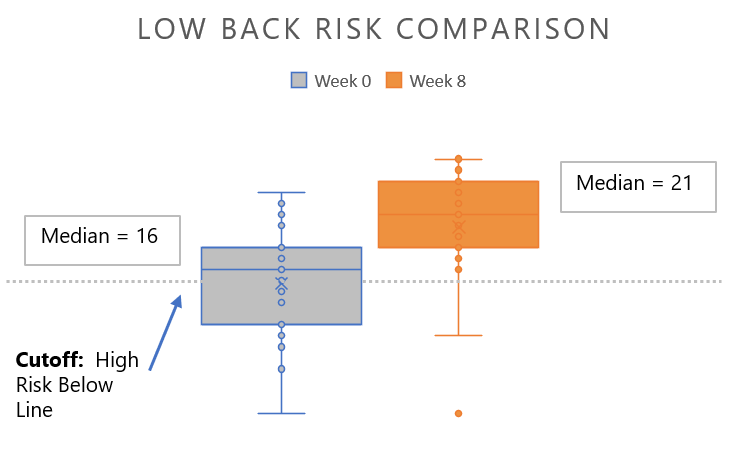
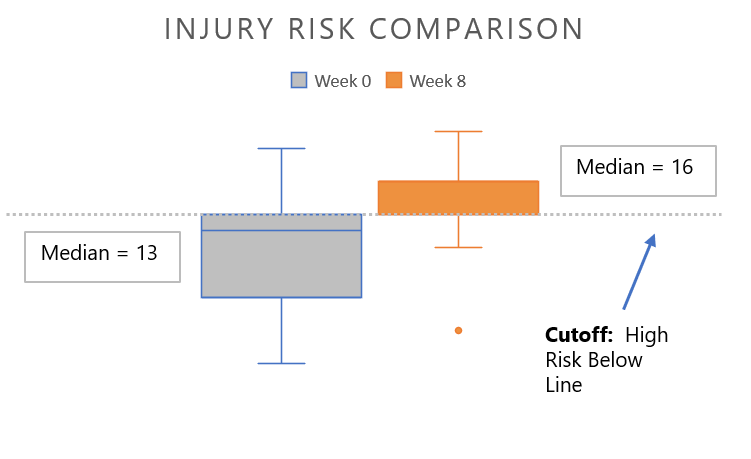
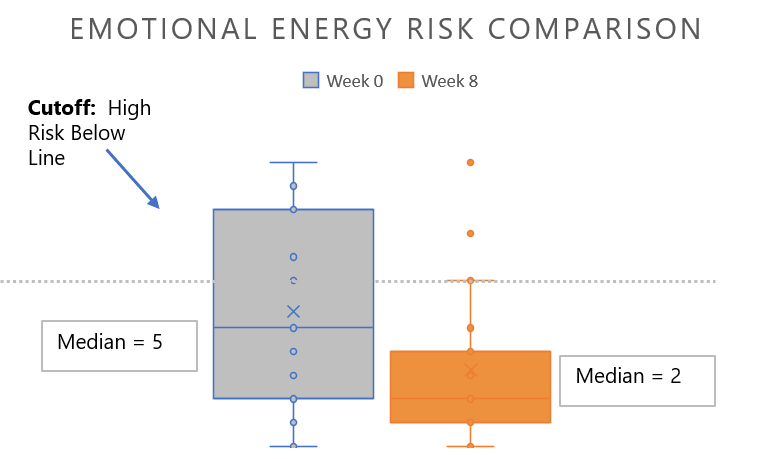
Matt has since run hundreds of his people through a year’s worth of our training and has this to say:
“You and your team have exceeded all our requirements and have been exceptionally professional in all aspects of performance of the programs. Everything - the assessments, the workshops, the online programs and the overall program management - have been exceptional.”
These results are commonplace and sustained. And while external validation isn’t what we do this for, our team has been pleased to be selected as a Top Corporate Musculoskeletal Program vendor by Shortlister for 4 quarters in a row.
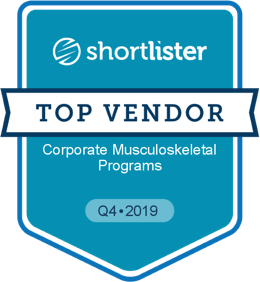
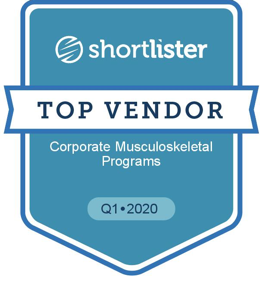
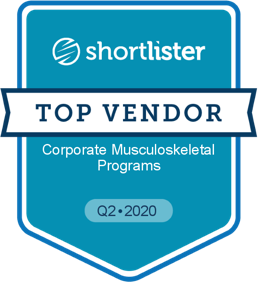

Who this is For
You are the leader or HR partner of a company or division who wants to ensure that employee physical and mental health is optimal, but you aren’t sure HOW to do this and you feel stuck and frustrated. You know you have a good team, but you hear about and see how health issues are sapping employee energy and the speed, volume and/or quality of their contributions.
You may have a wellness committee or have brought in speakers or coaches in the past, but you feel like it’s just...not...working. Engagement is not sustained, your data or observations indicate no real changes and it has begun to feel like it’s all a waste of time.
This isn’t your fault - your committee and most wellness vendors mean well, but if they don’t solve for the right combination of health, social, and education factors they will not be successful.
It’s also important to recognize the limitations of our healthcare system. Whether you provide health benefits or not, your employees are using providers that are focused on reactive care.
Quality of Care
The WHO ranked the US 37th in world in 2019 for the quality of the overall health care system, despite us spending more than twice as much on healthcare as a percentage of GDP than other developed countries.
Chronic Disease
The OECD reports that our chronic disease burden and obesity rate is also twice that of other developed countries. Among the same group of countries we also have the highest number of hospitalizations per capita for preventable causes.
That is what you are fighting against.
And that’s only been exacerbated by the coronavirus pandemic. Reactive care is not forward-looking - it has no plan - and does what we call ‘chase the pain’. Chasing pain is Health Whack-a-Mole. It keeps people busy, it keeps dollars flowing through the healthcare system, it solves the immediate issue, but doesn’t address root cause.
With politics as intractable as they are in the US, can you imagine any of that changing soon?

The silver lining is that as a company, if you can solve for employee health you win in the war for talent.
You will also be able to produce higher margins, possibly through increased revenues and definitely through improved productivity, reduced claims, and lower overall cost of an employee.
In order to actually have a sustainable impact on employee health you need to re-orient their relationship to health (i.e. they control their health vs health controlling them). The best and easiest way to achieve that is through MSK efforts.
Most people (including health pros and trainers, and definitely wellness directors) do not fully understand PRE-EMPTIVE MSK health and therefore miss out on the fastest way to re-orient employees’ relationship to health.
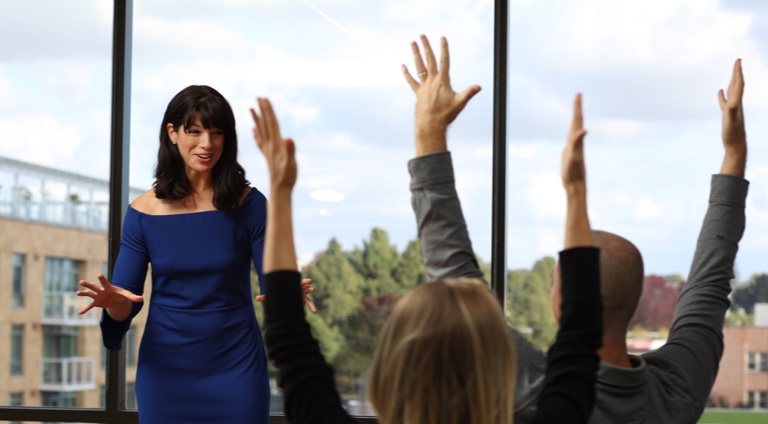
Here’s the truth.
You can eliminate NEARLY ALL MSK pain in employees if you teach them self-care techniques, create habits through online tools and reinforce those techniques and habits with quick and convenient access to experts.
However, most healthcare, fitness or wellness professionals do NOT have the knowledge, leadership presence and platform tools to do this cost-effectively.
We are the only people dedicated to solving this particular problem for SMEs.
Before we get into the steps and how tos, here is a quick background on our company, for credibility reasons.
We started this work in 2014. Our team has worked with the heads of over 1,500 companies to develop or revise strategic growth plans, has taught our approach to over 2,500 health & wellness professionals on 4 continents, and continues to lead in integrating mindfulness, food choice, down regulation, and strength training with clinical MSK healthcare to improve overall health outcomes. We have worked with populations as varied as the Navy SEALs to Midwest call center personnel. We have been recognized as a global Top Corporate Musculoskeletal Program provider for 4 quarters running
For those of you who aren’t familiar with us, we were founded by Dr. Theresa Larson, DPT (aka Dr. T) out of frustration with traditional musculoskeletal healthcare. Healthcare insurance reimbursements to providers create perverse disincentives for quality care, resulting in the common therapy plan of 12 visits to get a patient back to baseline function. Dr. T knew with her background - Doctor of Physical Therapy, Strength Coach, Professional Athlete and former Marine Corps officer - she could lead patients to get to OPTIMAL function in far less visits. (To this day, Movement Rx Physical Therapy patients achieve optimal function in 3.4 visits on average.)









The Movement Rx Method
The approach Dr. Larson developed - we call it the Movement Rx Method - worked so well that demand grew so quickly that the company had difficulty identifying the right talent to scale to meet the demand. Meanwhile we had been publishing videos on common topics but soon realized that people needed an organized recovery path. Out of necessity we digitized our assessment protocols and developed a series of recovery programs to replicate online what we did with patients in the clinic.
Boy are we glad we did.
Shortly thereafter we got a call from someone in the US Navy - the Southwest Regional Maintenance Center (SWRMC) to be precise. A program director had heard about us and listened to a couple of podcasts where we talked about the best approaches to solving back pain. Facing production issues due to a large percentage of personnel on limited duty with back pain, he called and asked if we had any Corporate Wellness programs.
"Yes," we answered.
So we scrambled to put together some professional looking slides, guess-timated a price point, and got an 8 week pilot program started.
The results were so drastic that we knew we had to pivot the business. An 83% reduction in personnel at risk for back injury. A 63% reduction in personnel in a state of emotional health crisis. A ridiculous jump from 4% of personnel considered ‘well’ to 74%.
So here we are, sharing with you.

What SWRMC did and how you can have a similar impact on your employee population.
Step 1: SWRMC Recognized Employee Health can be a Sustainable Competitive Advantage
A sustainable competitive advantage in the marketplace is the hallmark of a highly profitable company. Examples include pricing power due to high barriers of entry, becoming the low cost provider through economies of scale, and a handful of others, including the talent and skills of the workforce. With increasingly poor physical and mental health across the globe, those that can improve employee health will be creating a sustainable competitive advantage in their industries and markets. Those that DON’T take action will see their talent become a DISADVANTAGE.
In the case of SWRMC, that advantage was being able to complete maintenance of Naval vessels faster than before.
Core Competencies
When I was completing my MBA studies, I had the opportunity to work with management guru and author CK Prahalad. CK is the one who first coined the term core competency.
A core competency refers to a company’s capabilities in some activity that differentiate the company from its competition. If you can develop your employee health efforts into a core competency, that will become a sustainable competitive advantage very soon as competitors struggle with the consequences of poor employee health.
By nearly all metrics, health in the developed world is getting worse. Obesity rates are at 40% and are predicted to pass 50% this decade. 80% of people will suffer from low back pain at some point. Mental health issues - aka invisible wounds - are skyrocketing and are the leading cause of disability across the globe. All these feed into chronic disease. To wit, the number of people in the US with at least 3 chronic diseases is estimated to leap to 83 million in 2030 - nearly HALF of the US workforce - up from 31 million in 2015.
Obesity Rates
Obesity rates are at 40% and are predicted to pass 50% this decade.
Back Pain
80% of people will suffer from low back pain at some point.
Mental Health
Mental health issues - aka invisible wounds - are skyrocketing and are the leading cause of disability across the globe.
Complex Chronic Disease States
All these feed into chronic disease. To wit, the number of people in the US with at least 3 chronic diseases is estimated to leap to 83 million in 2030 - nearly HALF of the US workforce - up from 31 million in 2015.
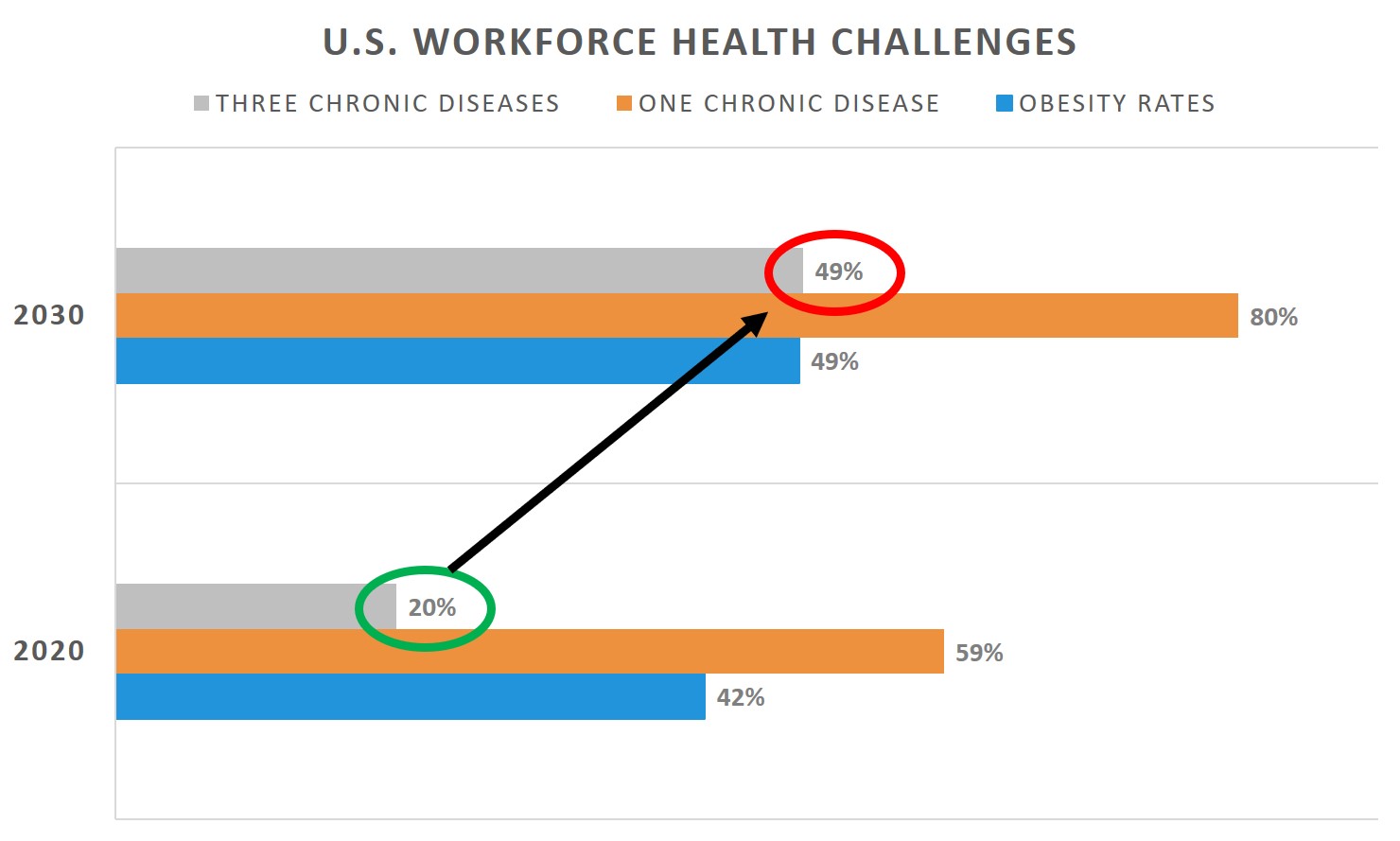
Let’s look at it through a different lens.
Based on our assessment data across all clients, roughly 50% of your workforce is in what’s considered an emotional energy crisis. The result? Anxiety and depression cost $1 trillion globally in lost productivity every year. Estimates vary, with the losses in the US as high as $190 billion annually.
Further, over 50% of your workforce is at high risk for injury due to movement dysfunctions. These dysfunctions are the root cause of over 87% of musculoskeletal pain and injury and $77 billion in US productivity loss.
So $276B across 150 million US workers is $1,700 annually per worker. To put those productivity losses in perspective, if your company’s annual net margins are 10%, that’s the theoretical equivalent of wiping $17,000 in revenue away PER EMPLOYEE. That’s $1.7 million for a 100 person company. What would you do to save an account worth $1.7m EVERY YEAR? Quite a bit, right?
Beyond the drain on financial performance, when employees are at risk, they usually know it. When they’re no longer at risk, they FEEL the difference. They’re happier and more productive. This ‘thrive’ mindset then feeds your company culture.
As you’ve probably heard, culture eats strategy for breakfast. However in this example they’re one and the same.
Take our Employer Musculoskeletal Health Appraisal to see where your organization stands.
(function() { var qs,js,q,s,d=document, gi=d.getElementById, ce=d.createElement, gt=d.getElementsByTagName, id="typef_orm_share", b="https://embed.typeform.com/"; if(!gi.call(d,id)){ js=ce.call(d,"script"); js.id=id; js.src=b+"embed.js"; q=gt.call(d,"script")[0]; q.parentNode.insertBefore(js,q) } })()
FAQs about Step 1
Would investing in a better employee health & benefits plan develop this core competency?
Better health plans MAY help encourage employees to use benefits, but you’re still relying on outside entities (local healthcare providers and plan administrators) to solve this for you. Often times, those outside entities have competing priorities, especially if you’re a small company. More importantly is you’d still be heavily biased towards reactive healthcare vs. managing for well-being.
What if our company doesn't have the budget to take on employee health?
Strategic advantages are rarely developed by focusing on whether they fit an existing budget. Budgets are short term, whereas an investments inherently have a longer view. Developing a strategic advantage requires investment, and an executive decision to evolve the budget or expand the capital base to make the investment. That said, developing employee health doesn't have to be a budget-breaker. Pre-emptive health education and behavior change can be cheaper than reactive healthcare by a factor of 10.
What if our company doesn't have the expertise to take on employee health?
This follows the answer to the previous question about budget. Expertise can be hired, either directly or through a partner.
Step 2: SWRMC Focused Their Wellness Efforts on Employees’ Movement Dysfunction
Research presented at a recent American College of Sports Medicine Annual Meeting here in San Diego showed that between 87-96% of all MSK injuries are preventable. It varies a little based on the area of the body, but the premise is clear: The vast majority of injuries can be avoided. The same goes for pain.
Our experience as clinicians and trainers tells us this is ultimately due to the person’s movement dysfunctions, which are FIXABLE. This creates an amazing opportunity.
To illustrate, we’ll highlight our CEO’s own experience with knee pain. Before his working career he was a collegiate and semi-pro athlete. He remained active until his early 30s when he began to experience knee pain. It progressed to the point where he couldn’t walk up or down stairs without 7 out of 10 pain (that's a lot of pain on a daily basis).
He went to the medical practice of the team doctors for the primary LA pro sports teams, thinking that would be his best shot at getting out of pain. A suggestion of surgery and a prescription for pre-op physical therapy was the result. Fast forward a year, past the surgery and another 9 months of rehab, and the pain was the same.
With frustration and resignation he just dealt with the pain, exercising lightly on the rare days his knees felt OK. Until he met his wife, a Doctor of Physical Therapy and strength and conditioning expert. She observed a number of dysfunctions - tight hips, weak hamstrings, poor ankle mobility among other things - and set about guiding him through those dysfunctions. Within a year he was out of knee pain, despite having no articular cartilage under either kneecap.
The key point is that movement dysfunctions are caused by a short list of factors. These include mobility - the % of normal range of a tissue or joint; Stability - the ability of the tissue and joint complex to maintain a position; and Motor Control - the brain’s ability to communicate specific patterning and muscle firing in the body.
Each of these can be fixed based on quick assessments of individuals’ particular dysfunctions and providing them a handful of tools to habituate better movement function.
Your Step: Assessments
See what to evaluate for Musculoskeletal Movement Function
We created an 11 point Musculoskeletal Movement Function assessment that provides employees a specific score and risk tier for all major joint complexes in the body.
FAQs about Step 2
How is this different from ergonomics or work conditioning training?
That set of training is great, but doesn’t address the root causes that will make it impossible for the individual to adhere to ergonomic or work conditioning guidelines. Without addressing the underlying dysfunctions, the employee’s movements won’t improve.
Do I need to have specialized education to fix employees’ movement dysfunction?
No. It can help, but it’s not necessary. Our whole approach is predicated on teaching employees to self-assess and perform self-care. You can do the same, too. In fact, we offer Wellness Champion training to do just that.
Mental Health amongst employees is a key concern of ours. Is there any way to connect that concern to movement dysfunction and pain?
Mental health is tricky because there are so many conditions captured in that category. Nevertheless, we know that the brain and body are connected, and we see improved emotional health outcomes when we create habits, reduce physical pain and the barriers that pain or injury represent.
Step 3: SWRMC Helped Employees See That Their Diagnosis Does Not Define Them
The majority of your employees are walking around with a spinal disc issue but have no pain. They likely have no idea they have a disc issue. If they were to get a MRI, they would receive a diagnosis. Despite the fact that the diagnosis would be meaningless, the employee suddenly feels restricted.
This plays out in most employee populations. At a recent multi-site cohort kickoff for Zovio, a paltry 7 people had signed up in the Phoenix location. Our team arrived two hours prior to the kickoff workshop and went desk to desk to encourage participation.
The two most common objection types (we measure these) were a) diagnosis or the related fear of doing something that would cause pain, and b) lack of time (when peeled back this objection is typically a cover for not wanting to feel embarrassed). Our team has heard these objections thousands of times and is adept at putting those fears at ease.
In those 2 hours, an additional 46 people signed up.
The point to that story is that modern healthcare is disempowering, and the prevalence and psychology of diagnoses are one of the primary reasons why. So many employees carry a diagnosis as a cross to bear, or they carry the PROSPECT of a diagnosis as a box to live in and a source of fear that causes them to do less. For MSK issues and emotional health issues, that’s the worst thing an employee can do.
Applied movement is the best prescription for any MSK injury or pain that is not immediately acute. Empowering employees with easy access to forward-thinking experts who are relatable can help empower them to make better decisions for themselves. The point is to re-orient their relationship to their health by allowing them to take control over it, as opposed to their health controlling them.
FAQs about Step 3
What type of experts do you suggest we coordinate or partner with?
For MSK issues the gold standard is a Doctor of Physical Therapy (DPT) with a strength and movement training background. To put a finer point on it, the DPT should be experienced with cash pay patients in a performance setting (as opposed to just insurance patients). That background is a useful proxy for finding a DPT that is accustomed to getting patients back to optimal, not just baseline (which is when insurance stops reimbursing the therapist and the patient’s care ends).
How does this fit into a Workers’ Comp (WC) model?
WC will always exist as an option for employees injured on the job. What we are suggesting is both a pre-emptive approach as well as an overarching wellness philosophy. WC cases have high rates of recurrence because of the factors listed above. Re-orienting your employees’ relationship to their diagnoses will help reduce recurrence.
How would we communicate this approach when we don't know which employees have which diagnoses?
Since health privacy regulations mean you won't know which employees have which diagnoses, broader health information campaigns are important. Such campaigns should address the fear, embarrassment and misinformation of musculoskeletal and emotional health.
Step 4: SWRMC Was Flexible Enough to Meet People Where They Were At But Still Have a Defined Curriculum
Employees vary in their place and vector along the health continuum. Generally, in every population a small percentage chase intensity and/or routine, half of the rest are too embarrassed, scared, or uncertain to take any sustained action, and the remainder are ready to at least try on new health activities.
To move the needle with your employee population’s health, the mechanisms - i.e. wellness program tools - need to be flexible enough to meet people where they are at all while minimizing wiggle room. By mapping entry points to employee health states and vectors, and then funneling participants onto one of a limited set of paths - curricula if you will - you create engagement, relatability and accountability.
SWRMC bought into the Movement Rx curricula which is predicated on advancing employees up what we call the Pyramid of Physical Freedom.
Establishing curricula taps into the natural positive social influences of an instructor to impress, plus the shared experiences and similar goals of others going through that curricula both current and past.
To illustrate - “You’re taking Chem 201? Me, too...that class is TOUGH. Want to study together?”
Eliminating curricula or making the path unclear makes it too easy for employees to regress to their standard health behavior vector.
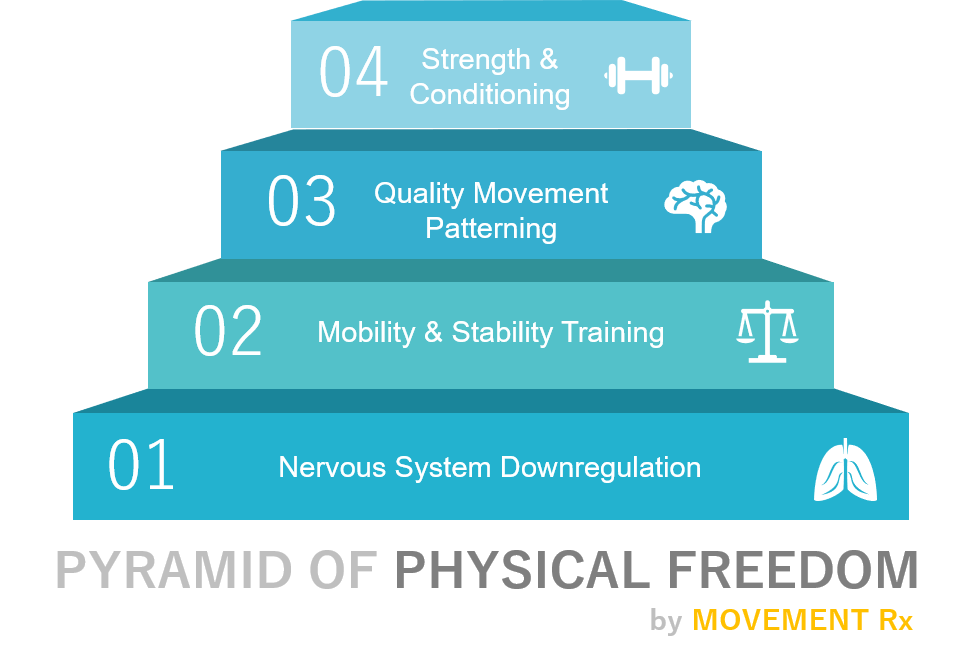
To highlight how this impacts the individual employee, let’s talk about ‘Betty’.
‘Betty’ works for Ashford University and is a middle aged woman that suffered from chronic hip pain. During initial program Q&A sessions, she confided that she was horribly embarrassed by her weight and was frightened by the idea of participating in a program. We convinced her she would be fine and that we could work around her pain. It only took 15 minutes to fill her sails - during the initial assessment we specifically identified where she had weakness and range of motion issues. This education ‘a-ha’ gave her a moment of control over her health.
The subsequent group accountability-based program and check-ins with our team helped provide the social influence to keep her onboard for the duration. These check-ins also made sure her fitness did not have to stop because of her hip. She learned how to scale and use her hip in ways that did not cause her pain that allowed her to complete the tasks of the program along with everyone else.
While we did not directly treat her chronic pain injury, we taught her key skills to help improve her strength and helped her participate in the program in a way that was healthy for what she was dealing with. She was thrilled at how much better she felt on a daily basis after 3 weeks.
Ashford provided Betty an entry point to wellness that she felt safe with. That entry point led to a pathway of programs and health coaching that served as a curriculum.
Take a look at this data that segments our clients’ employees by health state and vector. Our assessment data indicates that about 1/3rd of employees are considered physically and emotionally 'healthy'. Conversely, nearly 1/2 are in a tenuous health position, with over 1/5th at significant risk and worsening.
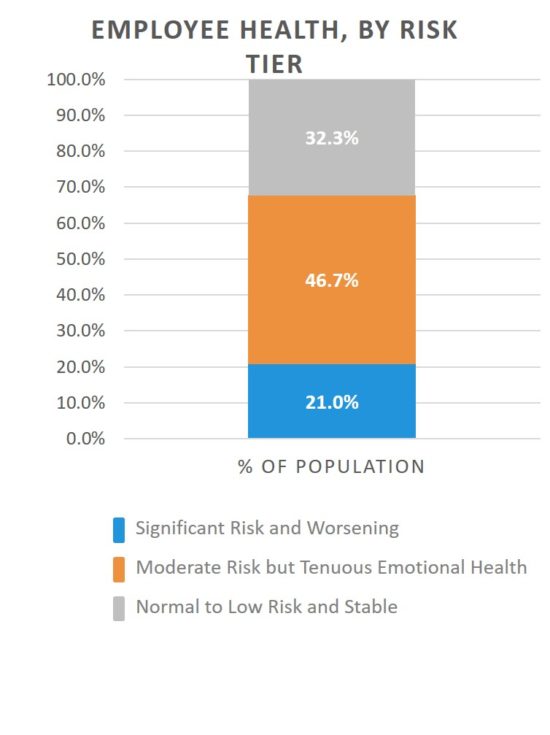
FAQs about Step 4
We have read that wellness should be customized to the individual. How does this relate to that concept?
Customized programs for the individual can be great, but they lose traction quickly with the vast majority of employees. These ‘independent study’ formats are great for the small percentage of individuals that are chasing intensity and routine - however those are the people typically less likely to need a wellness curriculum. While people are as different as flakes of snow, they’re still...snow. Health and wellness issues present similarly amongst the majority of people. There’s very little actual need for in-depth customization. In addition, the power of social influences on health behavior provided by a curriculum cannot be understated, and those are generally lost in the ‘independent study’ approach.
How do we get the ones who need it the most to engage with a wellness program?
It’s our belief that people are doing the best they can with what they have. Those who need the most wellness support often have the deepest fears or misconceptions about wellness. Like any consumer marketer, you need to better understand the core problems of those people and test the message and offering to see what they respond to. In general, that population WANTS to be healthy. You need to show them a SAFE path to start down. Then provide the resources that address and change root health behaviors - consistency, proper education, empowerment, relatable coaches or providers, and on-going support.
We've tried programs but get maybe 10% of employees to engage.
It's incredibly important to understand that sustained behavior change requires a long term commitment. Launching a new wellness initiative is great, but inevitably it will fail without consistent value (a pathway), communication (marketing) and accountability (support). Those components help build a culture of health, creating a flywheel effect that changes health behavior and reinforces those changes.
Let's take stock of what we just shared.
To summarize, what you need to do is:
Step 1
Recognize that employee health will be a sustainable strategic advantage OR DISADVANTAGE for your company.
Step 2
Focus wellness efforts generally on MSK health, and specifically on fixing movement dysfunctions.
Step 3
Develop outreach and interactions that help employees see that their diagnoses do not define nor stop them.
Step 4
Develop flexibility in HOW people start your wellness program, but optimize for sustained engagement and results by utilizing curricula.
With those steps you can see significant reduction in injury risk/emotional health risk in your personnel.
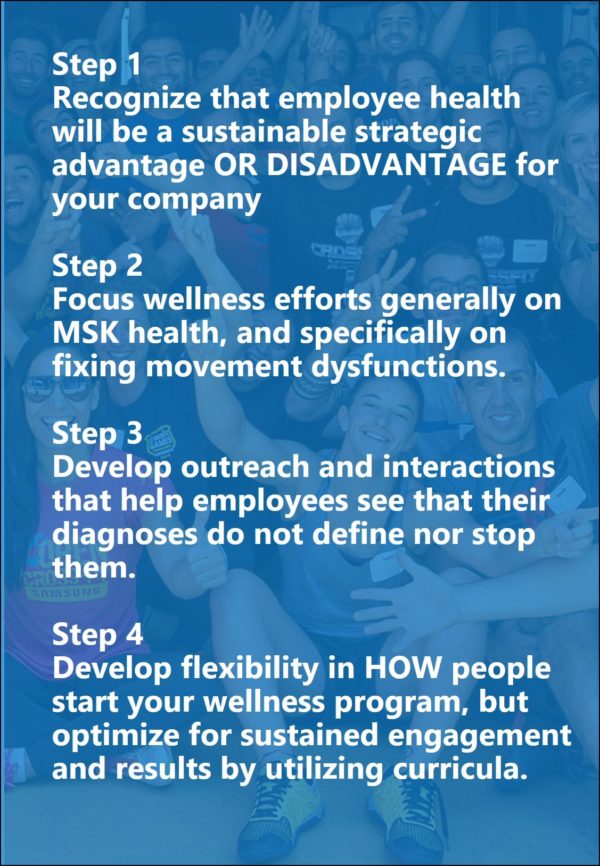
There are a couple of ways to achieve this.
The first option is to hire a musculoskeletal expert in-house. This will likely fail in the long run because of the following.
- If the hire is a health practitioner there are rules about what they can and can’t do when not employed by a professional corporation related to their field of practice. You might be able to get around this with $20k-$50k in legal fees and some other fancy regulatory footwork, but you’re taking on additional risk.
- You’ll pay minimum $80k fully loaded for an expert worth having aboard. In a state like California, that’s probably closer to $100k.
- That expert will be stuck creating 1-on-1 programs and will have limited time for broader wellness initiatives. Ask anyone with a MS, ATC, or DPT degree working in a corporate wellness position.
- You’d then need to invest $250k minimum in developing a digital platform to support basic health & wellness needs. If you want to integrate that with other health data or IT systems, double or triple that amount.
The second option is to partner with a local physical therapy or even chiropractic clinic. That also has its limitations.
- Not all PT or chiro clinics are created equal. Every single one would jump at a chance to do corporate wellness, but that doesn’t mean they can execute. Chances are you’ll swing and miss the first time or two.
- You’ll still be stuck in a 1-on-1 model, which gets expensive and has limited reach. A clinic with multiple practitioners can do a better job optimizing utilization rates than you can with a single provider, but you’ll be paying their margins.
- Plus, you will still be missing out on a number of other components critical to employee health - nutrition, mindset, fitness and behavior change.
The third option is to choose a fully digital wellness tool, but that will likely see limited results because:
- Despite scaling well, in the end people need other humans to guide their behavior change. We’re hard-wired to respond to people, not algorithms.
- There’s no connection to the people in the videos. There’s SIGNIFICANTLY better engagement when the people seen leading the videos are the ones leading workshops for employees and are the ones available for check-ins. Fully digital platforms have none of that.
You can choose any of those 3 options, or you can work with Movement Rx and get results in 8 weeks for 1/10th of the price of a FTE and with 1/100th of the effort.
Again, this is for leaders or HR partners of a company or division who are thinking strategically, who want to invest now for tomorrow’s business climate, and who want to ensure that employee physical and mental health is optimal, but who can’t figure out a way to achieve this quickly and sustainably.
How Ashford achieved this
Leo Patrick from Ashford University was dealing with incredibly high rates of MSK health issues, obesity, and employees scared of ‘normal’ wellness activities. In the words of Jenn Jung, Ashford’s Senior Director of Total Rewards, Benefits and Payroll, Leo’s location was “in a league of its own” in terms of health challenges. After 4 weeks of participation on the Movement Rx platform a transformation was underway, both physically and culturally. Leo remarked,
“I have never seen some of these people smile, EVER. Thank you for making that happen.”
These Box and Whisker charts contain the Assessment data from those 4 weeks. Note the significant reductions in risks for injury and emotional health crises as well as a reduction in participants’ levels of pain.

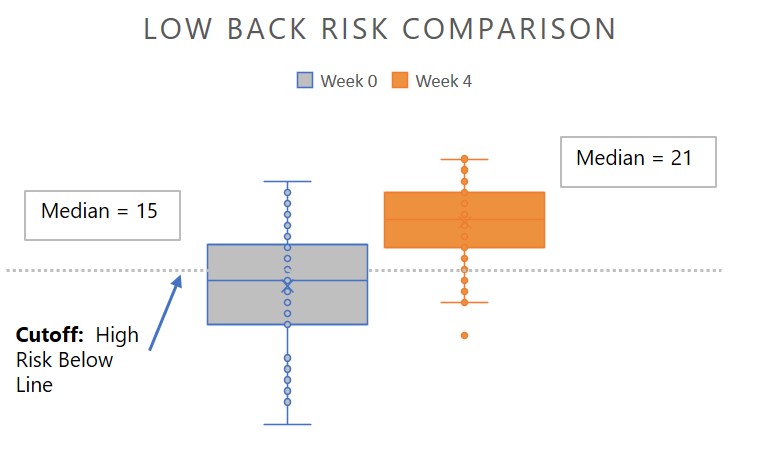
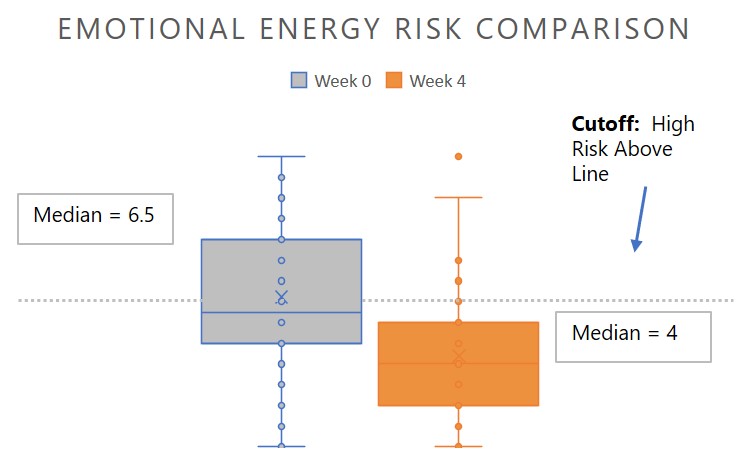
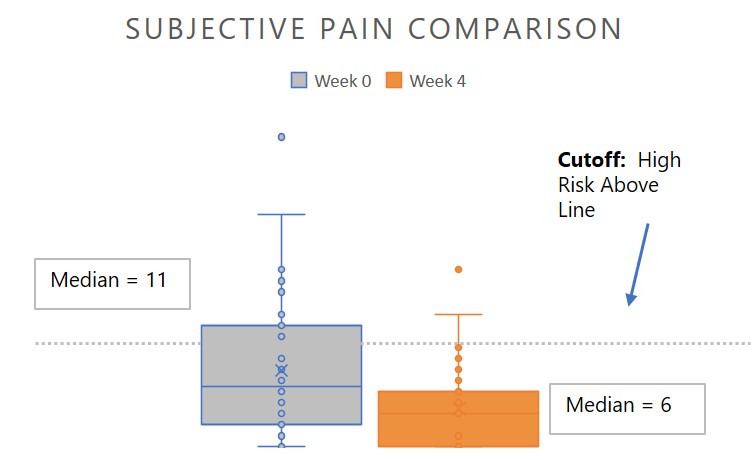
Not Enough Time?
Matt Cracraft from GreatCall was feeling defeated in his role as Wellness Director. When it came to finding ways to improve employee health, “I felt like I could not possibly do enough in my role to help the number of people we needed to help. I did not have enough time.”
"You helped us expand our reach and impact to all levels and types in the employee population.”
Working with Movement Rx “Allowed us to engage a different subset of the employee population. We have a population who is always participating in wellness. So with you all we were able to engage that new subset...the overweight, obese, those in pain, other issues that we would have not normally been able to engage. You helped us expand our reach and impact to all levels and types in the employee population.”
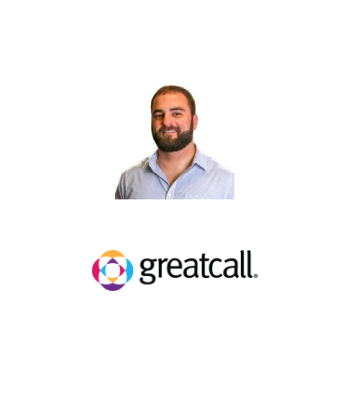
Want Results?
Here’s what will happen when you work with us. You will see TONS of smiling faces, and you will
Reduce Musculoskeletal Risk
You will be able to reduce the percentage of employees at risk for back pain by as much as 83% in 8 weeks
Reduce Emotional Health Risks
You will be able to reduce the percentage of employees in an emotional health crisis by 63% in 8 weeks.
Engage All Employees
You will be able to finally engage the dark unhealthy corners of your company by meeting your people where they're at.
Improve Productivity
You can even gain back as much as 25% productivity by reducing absenteeism and presenteeism.
Experience Gratitude
You will be thanked for the programs and people you have made available to employees and hear amazing stories of positive change
Be Empowered in Your Role
You will feel empowered to finally meet the full calling of your role, and not simply herd cats.
Have a Strategy
You will have a long term health & wellness plan and know that employees will take control of their own health vs being victims of a diagnosis or WebMD definition
Stop Feeling Alone
You can finally stop feeling alone in your role. You’ll have a partner to handle the load of being the health expert, educating employees, connecting with employees, providing ideas, tracking outcomes
Stop Feeling Sorry
You can stop feeling sorry for those employees that really need a helping hand in health, and actually DO something about it.
Save Your Energy
You can even stop being the health cheerleader (if you want).
How does it work?
We’ve built this so you can do things you’ve only dreamed of previously doing.
Want hard to reach employees to engage with Health Coaching? Start them on a simple challenge or workshop to allow our team to build trust, then offer them one of your company’s 1-on-1 visits with a DPT, fitness, nutritionist or mindfulness coach.
Want to have a consistent approach to health and wellness for employees? Have them take our simple assessments and we’ll provide them with a suggested path through our 80+ weeks of challenges and programs. They’ll get reinforcement of principles along the way through Office Hours, Live and Recorded Health Education Webinars. Plus they’ll get incentives and encouragement from the social features of the platform.
Want something for everyone in your organization without having to plan or manage it?
Here's what is available.
These can be self-managed by employees, centrally managed by you, or we can take care of it all for you. If you need something customized, we will work with you to see if anything additional makes sense, including Live Workshops, In-person kickoffs, 1-on-1 visits or classes.
Musculoskeletal Fitness Programs
Beginner, Intermediate and Advanced programs for joint health or fitness
Health Education
Recorded and Live Education on joint or tissue issues, fitness, nutrition, stress management, sleep, etc.

1:1 Health Coaching
1-on-1 Telehealth visits with a physical therapist, fitness coach, nutritionist, or mindset coach
Health Assessments
Robust yet easy health self-assessments that objectively measure root dysfunctions.
Mindfulness Training
Live Daily Downregulation and Breathwork sessions
Live Fitness
Live fitness classes for all levels
Access to Health Experts
‘Ask the Doc’ Live Sessions where employees can anonymously ask health related questions.
Health Challenges
Starter 4 week challenges that can be completed on demand or as a group.
Why Movement Rx?
If you previously tried or researched solving MSK health for employees, here’s what you probably found:
In-House FTE
Spending $100k-$130k/year on an in-house FTE with limited bandwidth.
Local Clinical Partner
Contracting out to a local PT or chiro clinic where the total cost to you and employees will be around $100/hour.
Rely on Workers' Comp
A Workers’ Comp maze where the average back pain claim is north of $40,000
Globo Wellness Platform
Globo wellness platforms that promise a ton but your employees are unlikely to engage with.
Not solving MSK health costs an average of $2,300/year per employee: $1,685/year in productivity loss PLUS $624/year in disability insurance costs.
And that’s ignoring the emotional health burden on employees and the unfunded liabilities that accrue with the increased risk of downstream chronic diseases in your workforce. That also ignores the drag on culture. Our full-fledged plans are as low as $699/month - between 1/20th and 1/10th of the cost of any alternative.
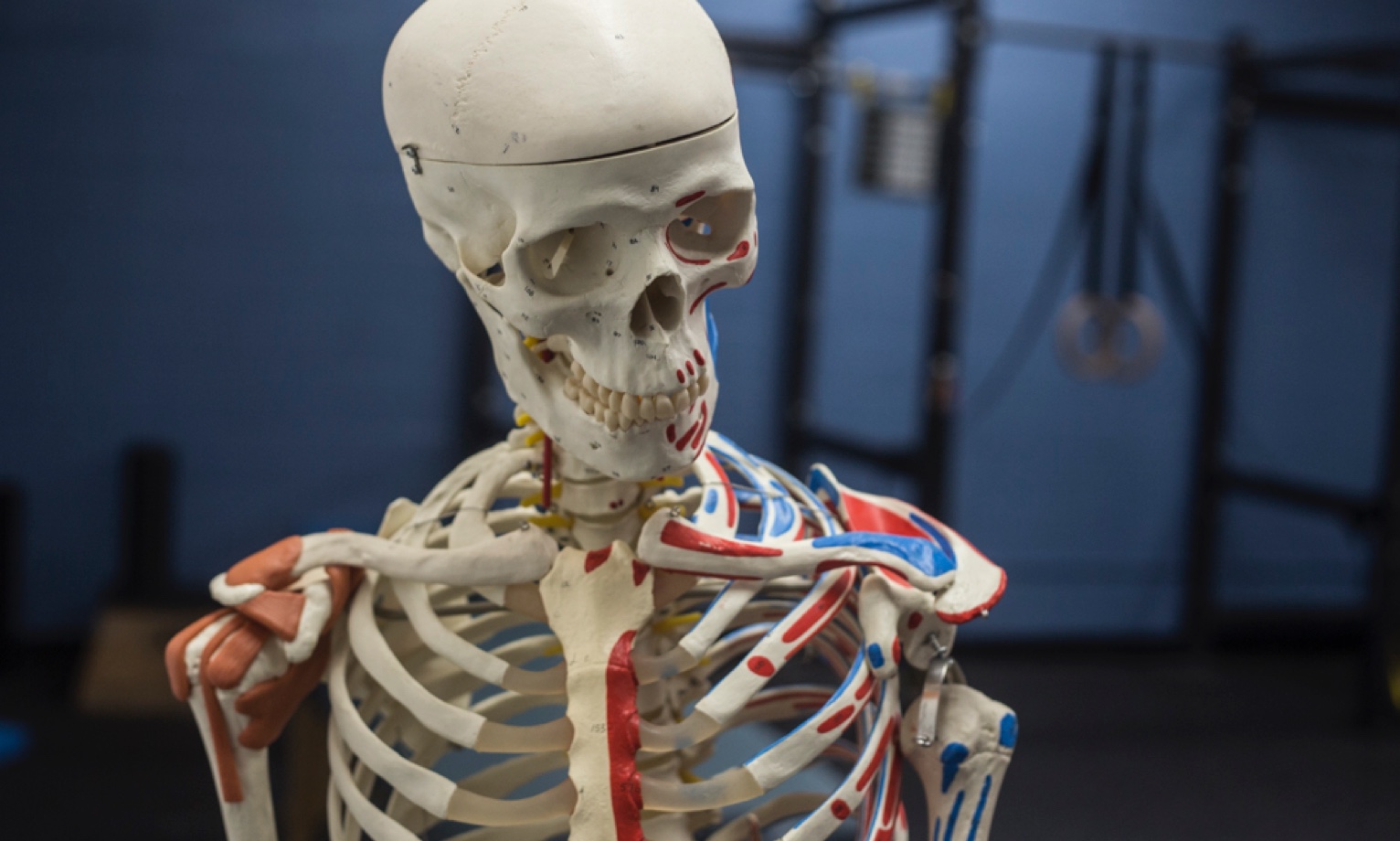
Here’s what you get
You get access to an award winning MSK Wellness platform that helps you easily manage engagement, participation and reporting.
On the platform are 80+ weeks of critically acclaimed programs for any type of MSK health issue. With over 25 different starting points to choose from you can use this to meet your people where they are at on their health journey and provide them a path to follow.
- Starter challenges for those with less confidence to build trust in our process and team. This segment of your employee base MUST trust your provider before being ready to build new habits.
- Beginner programs to help employees make a habit of quality movement and healthy choices.
- Intermediate programs for those who are already active but need guidance. THIS is the employee segment currently most at risk for acute injuries.
- Advanced programs for the highly active employees who want to go from ‘well’ to ‘fit’. By engaging this employee segment you make being fit more ‘accessible’ to your beginner and intermediate segments. (We call this the ‘Aspirational Pull-Through’ effect.)
- Employee access to expert Health Coaches for Q&A. These Coaches include physical therapists, fitness coaches, nutritionists, and mindset experts. The easier the access, the more likely employees will connect with health advice and not fall prey to misinformation.
- Employee access to LIVE and recorded education on a variety of health topics. This gives your employees additional inspiration and guidance on health behaviors they haven’t examined yet.
- Live Virtual Fitness Classes (for all levels). Make it EASY for employees to participate in fitness.
- Live Downregulation Classes (aka stress reduction). Make it EASY for employees to manage stress (and simultaneously improve tissue health).
- Free Telehealth Coaching sessions for employees (see the Bonus below for details). Provide the power of 1-on-1 coaching sessions to help employees with the most need - Pain, obesity, emotional health, etc. Or use these as incentives - employees LOVE our team.
- Account Management and Onboarding to make all the above as easy as pie.
Additional a la carte features to choose from include:
- Wellness Champion Training to empower specific influential employees to reinforce healthy habits and provide accurate info about the platform and available tools.
- Onsite or Virtual Kickoffs, Assessments or Additional Group Classes. Make an event out of launching the platform or launching a cohort on a challenge or program. In-person touchpoints leave an indelible impression that will improve long term engagement.
- Live Workshops. Host a live workshop (aka Lunch & Learn) to further engage your employees, specific departments or executive team.
- Annual Wellness Champion Summits to present insights, wins and challenges from the network of MRx clients.
All you need to do is book a H.O.P.E Session
HOWEVER, we only have the bandwidth to onboard 5 new customers this month, so if employee health is a priority for you then book a H.O.P.E Session and get your company in the queue.
Schedule your H.O.P.E. Session Now
BONUS
To encourage you to act now on behalf of your employees, we want to do something very special.
We’re offering you a 100% bonus that will REALLY help your employees’ health behaviors. For any tier you choose, your company gets 100% of that amount in cash credits. This may seem outlandish, so let us explain.
If you choose the $699/month tier, your company receives $699 in credits to use each month. Those credits can be used for 1-on-1 telehealth/coaching visits, live seminars, Wellness Champion training, additional classes, family memberships, etc. The offer stands even if you pay a year in advance. If you opt for the annual pricing of $6,990 your company gets ALL of that in credits to use on Day 1.
60 Day Guarantee
If employees don't see improvement in their physical function in 60 days, let's talk... If we can't quickly change that, we'll let you out of your contract. 100% no hassle.
To summarize the offer, you get:
- Award winning MSK Wellness platform
- 80+ weeks of critically acclaimed programs for any type of MSK health issue. This includes over 25 different starting points for any type of employee.
- Employee access to expert Health Coaches for Q&A.
- Employee access to LIVE and recorded education.
- Live Virtual Fitness Classes (for all levels).
- Live Downregulation Classes (aka stress reduction).
- Telehealth Coaching sessions for employees. Provide the power of 1-on-1 coaching sessions to help employees with the most need - Pain, obesity, emotional health, etc. Or use these as incentives - employees LOVE our team.
- Account Management and Onboarding to make all the above as easy as pie.
- 100% of what you pay in credits each period to use for employee visits or a la carte services such as Wellness Champion Training; Live Kickoffs, Assessments or Additional Classes; and Live Workshops.
- 60 Day Health Guarantee
All you need to do is book a H.O.P.E Session.
Schedule a H.O.P.E. Session Now
FAQs
How do we give you back 100% of what you pay us for platform access?
Well, we know our numbers well enough that even if you use EVERY SINGLE CREDIT we can still make a profit while helping you make it EASY for employees to make health changes. By making it EASY, we’ll all see improved results and we will undoubtedly ask to do a case study of those results for future marketing efforts. So there’s that.
Does this work outside of the case study populations above?
Yes. Our understanding of employee health risk has improved tremendously since the days of thinking that only blue collar workers were at risk for MSK issues. Further, sedentary lifestyles and poor nutrition choices have permeated every class and job type. We work with all types in our clinics, and the human body’s mechanics don’t materially differ from one person to the next. As long as your employees are homo sapiens, this will work.
What are the prices of the 1-on-1 visits and a la carte items we can add or use our credits for?
Those are our standard one-off prices in the market. 1-on-1 telehealth coaching sessions are $129/hour. Kickoffs and Workshops start at $500 for an hour plus any travel per diems. Wellness Coaching varies based on length, number of participants and travel time (if applicable). Assessments are $29 per employee. Onsite classes are $220 per hour for up to 20 participants.
What is the length of a contract?
Contracts are 12 months, although we encourage longer ones to ensure your commitment to employee health. We incentivize those with additional discounts and perks like Wellness Champion Retreats, for example.
Will this work for my company if it’s not in the US?
Yes, with some limitations for daily and weekly live services in some time zones. Our team is mostly based on the West Coast of the US, but we have served populations all over the world. For the UK and Western Europe, we schedule live sessions after 2pm local time. For Aussies and Kiwis, we schedule live sessions up to noon local time. If you’re anywhere between Dubai and Bangkok we are happy to do occasional live events, but until we add people in more convenient locations we would have limited live services for you. If that’s the case we have different pricing options.
What are the exact terms of the 60 Day Health Guarantee?
If the health assessment data from your employees does not show an improvement within the first 60 days, and you simply don’t want to continue, we’ll let you out of the contract and settle your account.

Schedule a H.O.P.E. Session Today
H.O.P.E. stands for Health Optimization and Prescription for Employees. The goal of this 15 min call is to see if we can help you or not. If we can help you, we'll put a gameplan together. If we can't help you, we'll have suggestions for who may. Either way, we'll provide you some HOPE.
Contact Us
Don’t hesitate to get in touch with any questions or feedback. We’re here to help!
Register for Your Account
Register for an Account
Start the Sleep Challenge!
Schedule a Well-Being Strategy Call
Submit your information below and our team will respond ASAP!
Workplace Wellbeing Inquiry Form
Government Contracting Inquiry Form
Application
